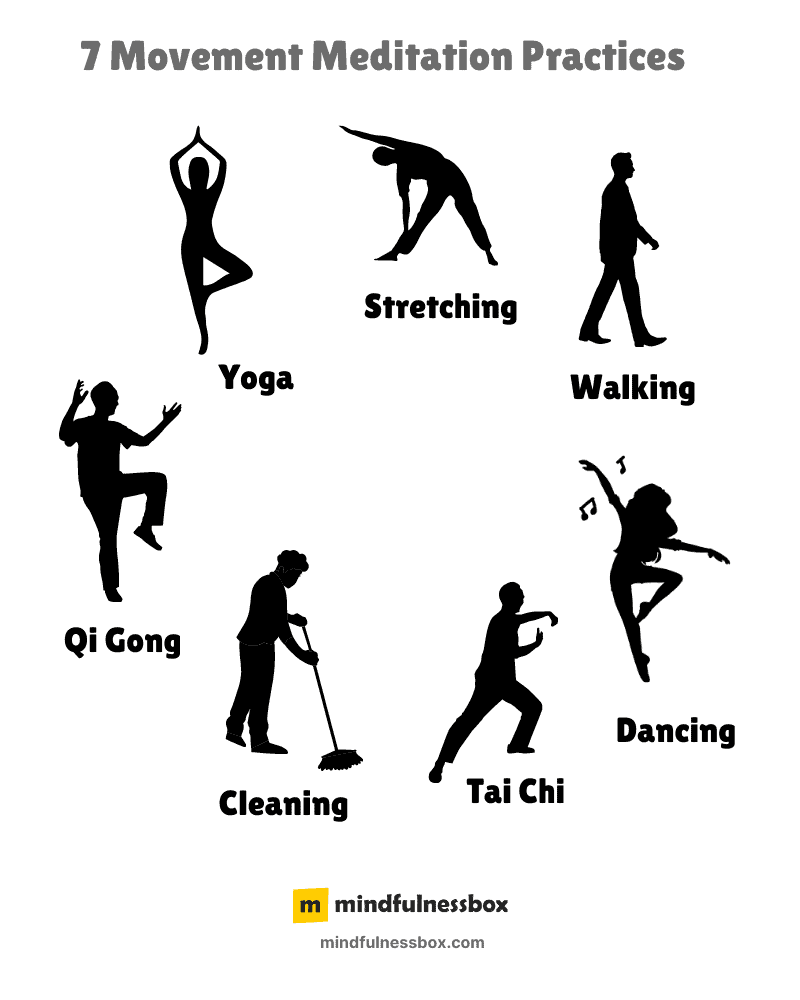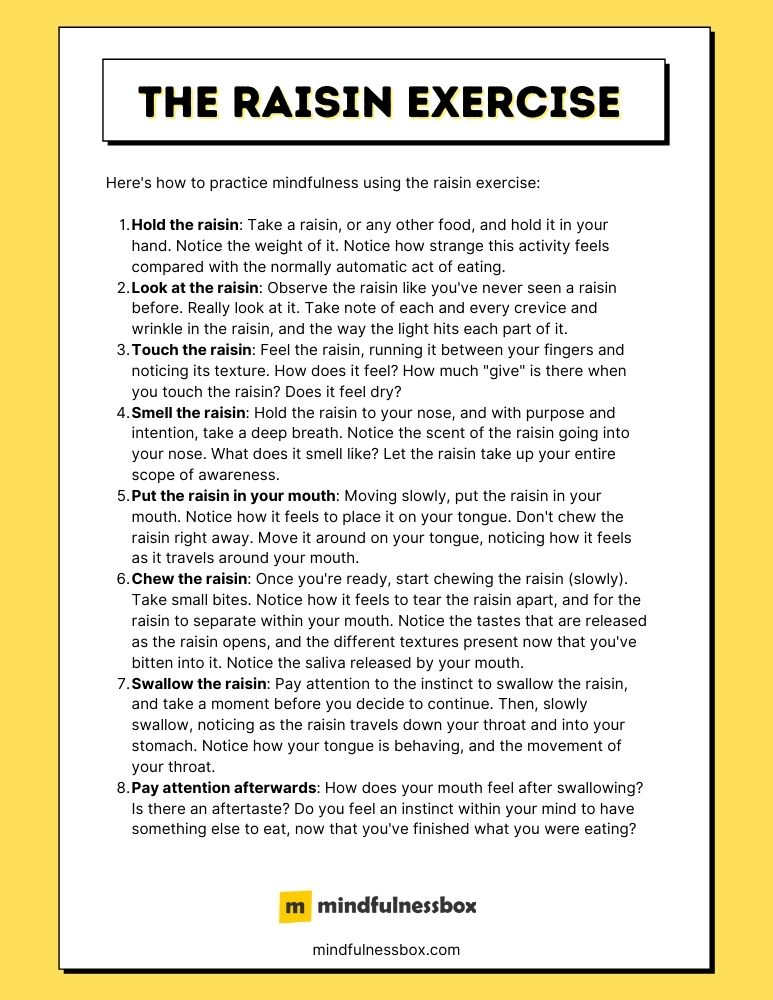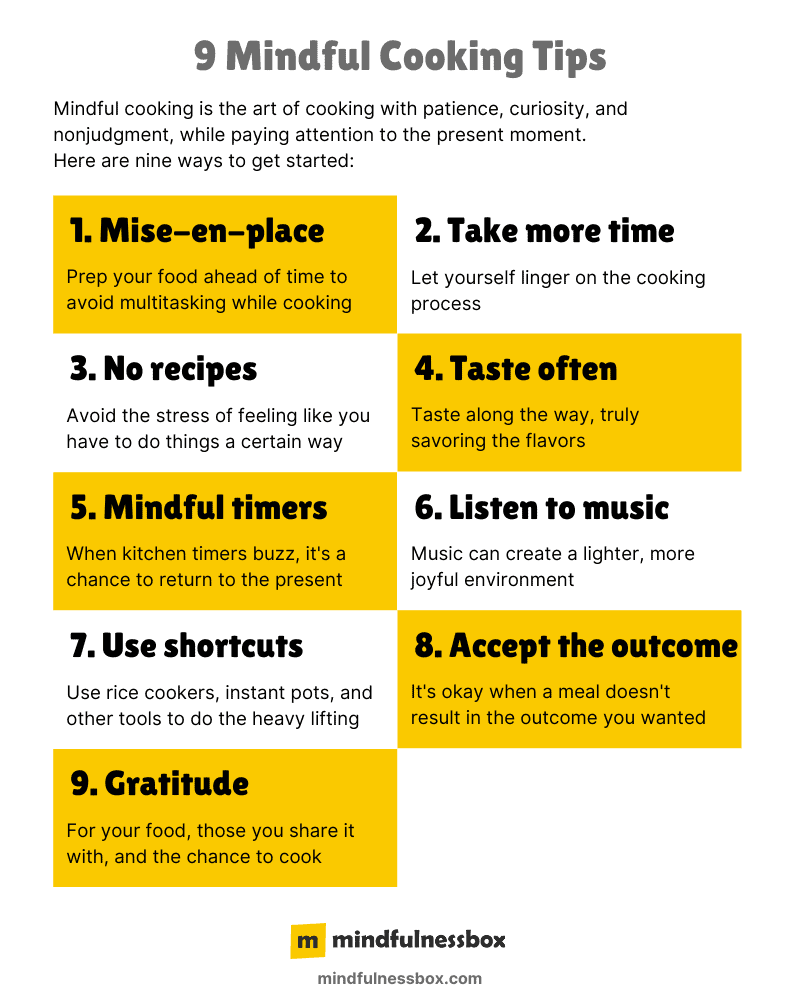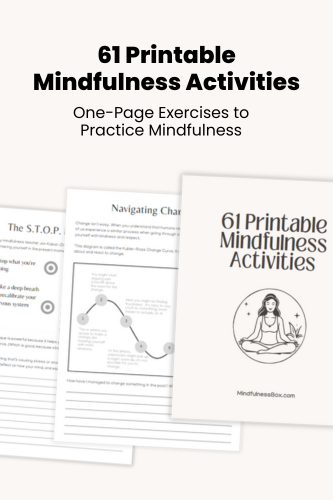Connecting with your partner requires intention and presence—things that can be challenging to cultivate in our busy modern lives. Mindfulness activities for couples help you and your partner enhance your bond by being fully engaged with each other.
Practicing mindfulness techniques together offers a number of benefits for couples. Mindfulness activities can reduce stress, increase intimacy, improve communication, deepen understanding, and cultivate empathy between partners.
In this blog post, we’ll explore some easy mindfulness-based activities tailored for couples that you can incorporate into your life. These practices only require a few minutes each day, but can have profound effects on your relationship satisfaction over time.
Get dozens of one-page exercises to help practice mindfulness, meditation, gratitude, and self love. Perfect for printable handouts when teaching mindfulness to groups, students, or in the workplace.
To see examples, plus a full list of the 61 exercises included, click below.
I’ve designed these couples’ mindfulness activities to be simple yet powerful ways to enhance closeness in your partnership. With an open mind and a bit of ongoing practice, you’ll be on your way to a deeper connection with your significant other.
13 Mindfulness Activities for Couples
1. Go for a couples’ meditation outside
If you’re looking for unique mindfulness activities, trying a meditation session outside together is a great place to start.
It’s great for rewiring your expectations about mindfulness as a couple. Mindfulness doesn’t require silence when you’re practicing together. Instead of trying to focus on your breath alone, try keeping an open awareness together, absorbing whatever peaceful nature sounds or city noises come up in your shared environment.
Next time you’re considering a mindfulness activity to do together, head outside – even if it’s a bit noisy. Of course, if construction work starts suddenly, you might have to put headphones on or head back inside. But tuning into the ambient sounds around you outdoors can add a new dimension to your couples’ mindfulness practice.
Paying attention to your surroundings can serve as a reminder to pay more careful attention to each other. Listening to the external world helps sharpen your ability to listen more closely to your partner too.
2. Give each other a 20 second hug
Hugging your partner is a great mindfulness exercise for couples and an easy way to boost your bond through physical touch.
When you’re stuck in a cycle of stress or negativity, more thinking often won’t solve the problem – but affectionately moving your bodies and intentionally connecting can help recalibrate your nervous systems.
Research shows that hugging for at least 20 seconds enables your bodies to release oxytocin, the “love hormone” associated with bonding. So next time you and your partner need to destress or reconnect, try a mindful hugging session.
Stand facing each other and slowly lean in for a warm, comforting embrace. As you’re hugging, invite your partner to take three deep breaths with you, in order to balance both of your nervous systems and boost oxytocin. Tune into the sensations and emotions that arise as you hold each other.
After your mindful hug, gently release the embrace and take a moment to check in with how you each feel. See if stress has lowered or your sense of closeness has deepened through that simple, devoted contact.
3. Practice movement meditation together
Did you know you don’t have to sit still together in order to practice mindfulness as a couple? Many people forget this.
If you’re looking to get into mindfulness activities together, consider incorporating some movement-based practices in addition to seated meditation.
Try experimenting with tai chi, qi gong, gentle dancing, walking meditation, or other forms of mindful movement. Movement meditation offers a more interactive style of mindfulness that connects you to both your inner landscape and your partner outwardly. The synchronization required by practices like coupled dance also encourages letting go of judgments and being in sync emotionally. As you learn to coordinate physically, you build skills for harmonizing mentally and relationally too.
Starting or ending your couples’ mindfulness sessions with mindful movement can be very centering and connecting before sitting down to meditate. Transition smoothly into presence with each other through simple, conscious movements first.
So next time you carve out mindful time together, lead with some movement-based mindfulness. Walk silently, mirror each other’s poses, sway gently to music – then seat yourselves with greater attention and alignment.

4. Practice mindful eating together
If you and your partner will be sharing a meal or snack, consider making it a mindful eating session. Eating often becomes an automatic process that distracts us from each other. But it can be a connecting mindful experience for couples instead.
Here’s how you can intentionally dine together:
- While eating, gently stop yourself if you notice you’re consuming on autopilot.
- Then, shift your attention back to your partner.
- Try slowing down the pace, and pay attention to the texture and flavor of the food and drink together.
- Savor a piece of food and comment on how it tastes and smells.
- Notice how the meal feels as you both slow down and pay more attention to each other’s presence.
Making small talk can pull you out of the moment too. So try enjoying a few bites of your meal in silence together, simply tasting and appreciating the food itself. Then, resume present moment conversation, keeping it light and centered on your shared dining experience.
Dining mindfully side-by-side builds intimacy through mutual presence. It allows you to tap into all of your senses as you synch up your pace and focus. Next time you grab a bite, make it a nourishing chance to nourish your bond over the natural pleasure of flavorful fuel.
The raisin mindfulness exercise is a good place to start.

5. Listen to music mindfully together
This activity is easy to incorporate into relaxation time together to build intimacy. Just put on headphones, pick a song, and set the intention to listen attentively together.
You may want to play the song once without any guidance, then replay it after agreeing to both try diving deeper into mindfully noticing the sounds, chords, instruments, and vocals arising. Tune into both the music and your partner next to you.
Picking a song that’s entirely new to both of you can make it easier to approach the listening session with beginner’s mind and without preconceived notions. This makes it simpler to focus on your sensory experience in the moment rather than thoughts about the song.
Allow the song to immerse you in the present as you absorb it with your partner. When attention wavers, reconnect with the sounds and with your partner’s presence.
Afterwards, discuss your experience listening consciously side-by-side. Did this mindful music activity help deepen your sense of connection?

6. Find ways to be playful together
As we grow into adulthood, some of the playfulness of childhood naturally diminishes under mounting responsibilities. That’s why helping couples reconnect with play is one of the quickest ways to not only loosen up together, but to help partners have fun while authenticating their bond.
If you’re looking for an easy way to be more mindful together, approaching your relationship with a playful, childlike attitude is a great place to start. Being silly and laughing not only loosens you up in the moment – it loosens up ingrained perceptions you have of each other.
Try an activity like staring into each other’s eyes for a minute straight without talking or looking away. The awkwardness is sure to crack you both up! Or have a mini dance party in the living room together to let go of self-consciousness. Play an impromptu made-up game requiring goofy gestures and sounds that tap into spontaneity.
Injecting play into your time together opens the door to presence and possibilities. It enables you to set aside roles and expectations to just bask in each other’s company. Laughter and levity strengthen bonds – so engage in mindful play!
7. Practice breathing exercises together
Breathing exercises are a classic mindfulness activity for couples. Box breathing is part breathing technique, part visualization exercise that powerfully links your shared attention. It’s simply another way to practice staying grounded in each other’s presence while calming your nervous systems.
Because of box breathing’s effect on relaxation and alignment, it can be an excellent starter for couples’ mindfulness sessions.
Stand or sit facing your partner. Instruct them to inhale slowly for 4 seconds as you mirror them. Visualize moving up the left side of a square together in your mind’s eyes. Then hold your breath for 4 seconds, mentally tracing the square towards the right. Exhale down the right side for 4 seconds as your partner does too. Finally, pause for 4 seconds at the bottom before inhaling back up the left side.
Repeat this sequence a few times, maintaining eye contact and breath synchronicity. Feel your heart rates slow and presence with each other deepen. After a few rounds, notice if you feel more centered and connected through that simple shared breathing exercise.
Whenever tensions build or attention scatters, come back to box breathing. Let the steady square outline reorient you to inner stillness and interpersonal harmony. Inhale unity, exhale separation, until your rhythms realign.
8. Take a walk in nature together
A leisurely stroll outdoors is a soothing yet engaging way to connect more deeply with your partner. A mindful nature walk allows you to leave daily stresses behind.
As you explore your surroundings, pause frequently. Take some shared mindful breaths, lean against a sturdy tree trunk, gaze outward from a vista point or trail overlook. Tune into smells of vegetation or sounds of birds calling to each other across the landscape.
Holding hands as you walk promotes warmth, affection, and unity. It also serves as a helpful anchor whenever your attention threatens to drift into planning mode or constant conversation. Simply give your partner’s hand an intentional squeeze to reroute your awareness back to the present.
Vocalize observations and sensations from time to time to weave another layer of connection. But also embrace stretches of walking in silence together to fully absorb the sights, feels, and sounds enfolding you. End your outing with an expression of gratitude for nature’s beauty and your shared glimpse into it.
9. Practice mindful listening together
Here’s some advice most couples get on their wedding day: “Communication is key.”
But what people are really saying is this:
Your partner needs to feel heard and understood by you.
Mindful listening sessions are, admittedly, hard to do as an exercise; it can feel artificial if you don’t go into it with the right mindset. But if you can manage it, you may find it’s wonderfully productive for your relationship, and is essential “practice” for forging an atmosphere of understanding essential for weathering conflict.
Start by sitting facing each other, setting aside phones and other potential distractions. Set a timer for 5-10 minutes each. One partner shares uninterrupted about any thoughts on their mind while the other listens attentively. The listener focuses completely on the speaker, without thinking ahead to responses or solutions.
As the speaker, stick to “I statements” and take care not to blame or criticize your partner. As the listener, offer only supportive comments like “I appreciate you opening up about this” or “I want to understand where you are coming from.” Resist problem-solving or offering advice unless directly asked.
Once time elapses, switch roles. The listener summarizes back the essence of what they heard for clarity. Make space for any lingering thoughts, then discuss how mindful listening felt. When disputes arise later on, come back to this exercise first. Intentional presence and a bid for understanding must precede progress.
10. Try couples’ yoga
Yoga is inherently a personal journey of mind-body awareness. But modifying your home practice to involve your partner can deepen your connection.
Synchronizing breath, balancing weight, mirroring movements – yoga for two cultivates unity.
Start by finding 10-15 minute beginner yoga sequences for couples online or through yoga apps. Even if one partner is an experienced yogi, meet each other at a basic foundational level at first. Stand facing each other, establishing steady eye contact and breath alignment before flowing through motions side-by-side.
Practice leveraging each other’s weight or resistance to deepen certain postures. Mindfully adjust angles to ease a struggling partner into proper alignment rather than forcing. Offer verbal guidance and praise freely, making sure both partners feel empowered in their practice.
Over time, progress to more challenging couples’ poses requiring greater trust and coordination. One partner relies on the other’s sturdiness and balance for support in feats like AcroYoga lifts. But approach in gradual steps, from simple seated twists or palms-connected warriors to elaborate stunts. Let the emotional gains and sense of togetherness motivate you as much as the physical gains – unite on the mat so you can unite better off the mat.
11. Unplug to connect more deeply
It’s far too easy in our digital era for devices and screens to creep into couples’ time, fracturing attention and intimacy. That’s why establishing sacred stretches of tech-free togetherness is key for nourishing understanding and affection.
Commit to setting aside time to power down phones, tablets, laptops – any gadgets prone to distracting you from each other. Gently remind one another if you catch your partner unconsciously reaching for a device out of habit. Technological stimulation can wait; prioritize emotional and mental convergence.
With electronics out of the way, let conversation meander organically without pressure to problem-solve or mend disagreements. Or envelop yourselves in comfortable silence as you cook dinner side-by-side, snuggle on the couch with books, take an evening stroll around the neighborhood.
Pull out a board game to pass time playfully. Exchange light back massages or foot rubs. Sketch portraits of each other, no artistic skill required. The goal is simply to be fully present – make eye contact, truly listen, soak in each other’s company without tech-fueled diversion.
Occasionally, go a full 24 hours screen-free together for an intensive relationship reset. You may experience withdrawal at first. But creativity and conversation will replace numbing scrolling given space. And you’ll uncover just how rejuvenating it can feel.
12. Cook mindfully together
Preparing meals together doesn’t need to feel like just another domestic chore. Instead, an evening in the kitchen can offer the perfect recipe for couples’ mindfulness and quality bonding – no rush required.
Choose a new, multilayered recipe that requires time and teamwork; something you’ve never attempted before together. Read over the instructions fully to assemble ingredients and tools needed, then dive in, remaining open to enjoying the present moment journey as much as the final dish.
As you chop and stir, serve each other tasters of various components. Pause to fully savor every texture, smell, and flavor. Sink your awareness into your senses rather than letting it dart to other thoughts or tasks. Tend to the stovetop and simmering liquids with care, tuning into aromas blending and bubbling tones, tasting for seasoning along the way.
Wash produce, sweep up spills and wipe counters without frustration, sticking close in the cozy workspace. Discuss challenges, suggestions, favorite cooking memories. However the meal turns out, celebrate one another’s collaboration through a candlelit feast at the little corner table. After you dine, maintain the mood’s unhurried intimacy a while longer. Clean up can wait; nourishing your connection deserves more mindfulness.
The simple act of cooking consciously, grounded fully in the body and in your togetherness, weaves powerful relational magic.

13. Start a gratitude journal together
Life’s hustle and stress has a way of eclipsing all that is going right in our relationships. That’s why an ongoing gratitude ritual can work wonders to revive perspective and affection that may have faded.
Commit to keeping a shared journal, digital or physical, where you and your partner log things large and small that you feel grateful for about each other and your partnership. Make entries together or take turns adding to it solo whenever inspiration strikes.
Shine light on qualities your significant other possesses that you cherish: emotional availability after a long day, reliability when plans go awry, playfulness during mundane tasks. Write thank-you notes for thoughtful gestures like a fresh pot of coffee waiting or the car tank filled up.
Spotlight your favorite memories together too – the night you danced in the rain on vacation or cleaned up after your kid’s art project and ordered pizza. Even seemingly simple joys deserve celebrations when you view them through the lens of gratitude.
On tough days when irritation prevails, reread this growing record of appreciation and affection. Recall how devotion manifests behind the scenes. When communication falters, let hearts lead instead of heads.
Stay anchored in gratitude’s calming perspective. The synergy and care that grace your best days still lives within and between you, awaiting mindful unveiling. Together, reject stagnancy’s pull by consistently giving thanks for the extraordinary ordinary magic of “us.”

My mindfulness practice kicked off in 2016 with a ten-day silent retreat. Since then, I’ve read dozens of books about mindfulness and completed hundreds of hours of meditation. Thinking about what makes humans happy, calm, and peaceful is endlessly fascinating to me.


